Introduction by Coach Kym
This is a beautiful epic story of a single race by a self described “mediocre” runner. You might be inclined to think “why do I care about a middle of the pack runner?” Don’t we usually get our inspiration and direction from Olympic level athletes? Or the other end of the spectrum, the tragic-to-triumph stories? Yet, aren’t most of us middle of the pack average athletes? Most of us will rarely (or never) be on a podium or be dead last either. Most of us are not overcoming monumental obstacles, just the mundane ones. That doesn’t mean your story isn’t any less important or inspirational. As is Sara’s.
In January 2016 Sara came to me for coaching. Her goal was to solo backpack the 30mi outer mountain loop of Big Bend National Park in early 2017. With a year of specific training and preparation hikes, she was very successful. Later that year she backpacked 50mi in the Wind River mountain range of Wyoming. These and other backpacking trips were and continue to be what feeds her soul. Yet in 2018 she decided to train for her first running event. She skipped right past 5k and even marathon. Her first race was the Zumbro 50mi in April. It happened to get the most classic Minnesota spring weather; snowy blizzard, gale force winds, sleet, and knee deep mud. Between battling a mysterious knee injury and wildly challenging race day weather, many people would have gotten out of ultra running. Sara has embraced the constant problem solving of both her body and logistics continuing to do two other very successful 50mi ultra-runs before this story of her Bigfoot 43 mile ultra race.
It has been an honor to coach Sara through these years. I am so proud to have guided her from novice athlete getting used to following a five hour a week training plan, to now where she writes her own complex plans.
I hope you enjoy her story of this one long day that was years in the making.
Prologue
It took me three years to actually get to the start line of this race. I was registered for the Bigfoot 43 mile ultra run in 2019. Then I broke my foot the week before taper after losing a game of ankle bingo on the diabolically rocky and rooty Crosby-Manitou section of the Superior Hiking Trail. The 2020 Bigfoot race was cancelled due to COVID, which was fine by me considering the shape I was in after living in the middle of social unrest and then moving halfway across the country that summer. There were other races I could have entered, but it’s never really been about “racing” for me and the challenge of this particular course and the race format became a mini-obsession.
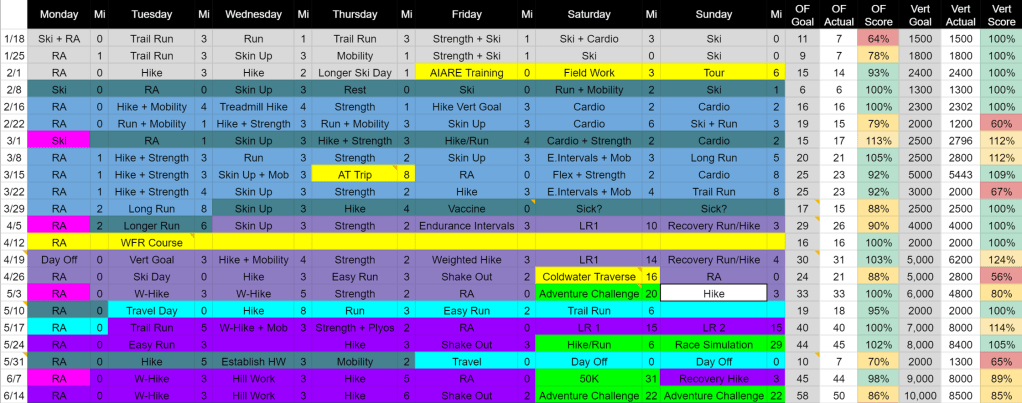
The Course
This “40 miler” is really a 43.5 mile circumnavigation of Mt. St. Helens. The race is described on the course website: “Explore the incredible terrain of an active Volcano including the 1980 volcano desolation zone, old growth forests and some of the most remote terrain in the USA.” While there are no entry requirements, they caution: “GRADUATE level race requires self sufficiency and experience in the backcountry. We recommend that runners consider that this is a tough 40mi race … There are very few locations where runners can drop out of the race, please do not enter if not sufficiently trained and prepared. There are limited number of aid stations, just two!”

Elevation gain and loss is a little over 9,000 ft
Cutoff: 18 hours
What’s really cool about the course is the opportunity to experience significant changes to a mountain made in recent history, rather than trying to wrap the mind around landscape evolution on a geological timescale.
The remoteness is also really appealing–with only two aid stations it felt like way to connect with the mountain in sort of slow, visceral, and meditative way.
The time goals
A: Finish in 12 hours. B: Finish in 13.5 hours. C: Finish at all.
Taper and pre-start
Let’s start with where things needed to start, which is with a thorough mental cleansing. I don’t know that I agree with the “90% of an ultra is mental” truism, but where you’re oriented mentally and emotionally definitely has a big impact (case in point: the flaming goat rodeo that was the Coldwater 16 a few months earlier, before which I ugly-cried in the car and then proceeded to have one of my top 5 Worst Runs Ever).
I still haven’t mastered the art of the mental taper and, instead, tend to use the decrease in training to “catch up” on travel and social activities and let work fill even more mental space. Which means I end up trading discipline for complete emotional chaos, which creates training inconsistency, which routinely messes up my taper. This is not a good habit.
The week before Bigfoot, I had a horde of mental goblins jackhammering away at my synapses. I decided to give myself until boarding the plane on Thursday to ruminate, but vowed to hit the “reset” button as soon as I sat down. It worked, thankfully. This is similar to the strategy of only granting permission to suffer until I reach a certain tree or other visual landmark. You can’t silence the angst entirely; you just have to timebox it.
Mental goblins silenced, I met Louis (partner) in Portland and we drove up to Marble Mountain Sno Park on Friday morning and snagged a spot for our massive new car camping setup. This has been a long time coming but, let’s face it, was inevitable after the first time I went camping with friends and they had a tent they could stand up in, cold beer, and real pillows. If I have to sleep outside the night before a race, I want a real pillow. So we pitched our new six-person tent, drove to the Lone Fir Resort in Cougar for huckleberry lemonade and a veggie burger, and waited out the heat. Given the 73-milers’ 5:30 am start, the campground/parking lot quieted down early, and it was perfect sleeping weather.
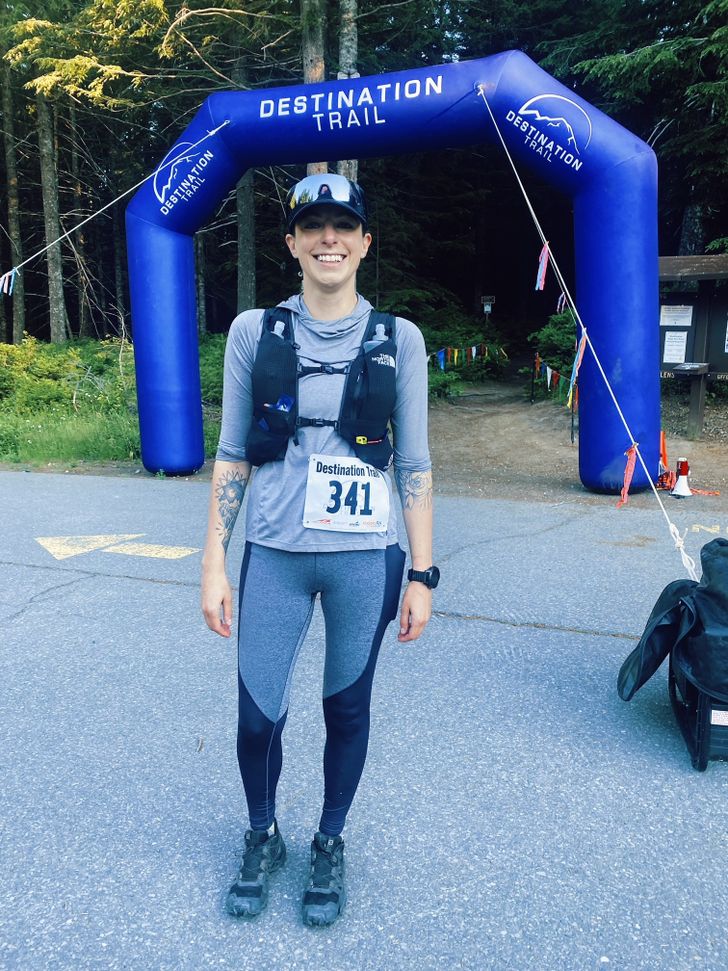
The First 12 Miles
My least favorite part of a race is the start. I do all my running alone and that’s when I’m living my best life. It’s alienating to suddenly become part of a gigantic knot of anxious humans in athletic wear, especially when the knot starts moving and the conga line forms. Thankfully the first couple miles of the course were plenty wide for people to resituate, and for me to position myself a bit further up than I usually do, considering the first 5 miles has over 2,500 feet of climbing and one of my spirit animals is a pack mule. Climbing is my very favorite thing.
For the first four or so miles, the trail is gently through old growth trees and singletrack. Then come the boulder fields.
I’m relatively comfortable tap dancing on talus (pillow sized rocks), but early in the race people were still close enough for things to get a little social and disorienting. Because there isn’t really a “trail” to follow, I had to locate a flag in the distance and then return my gaze back at my feet and move in that direction.
A friendly guy from Tucson was behind me and we chatted and worked well together, but when we got caught up in a bigger group I was no longer navigating and just sort of blindly followed the people in front of me…until they realized they had gone off course. Only a quarter mile off, but ouch.
Tucson Guy and I stuck together for a good chunk of the downhill to the aid station. While I normally prefer to run solo, I can see how running socially makes it feel easier. It was actually pretty fun to chat and before I knew it we were rolling into the aid station. After the boulder field (and knowing they come up again very late in the race), we were both a little pessimistic about our finishing times, but I was really happy to see that he finished hours ahead of when he thought he would. Tucson Guy, you made my heart grow three sizes that day.
A key part of my race strategy is to get in and out of aid stations as quickly as possible. I don’t like resting anyways and, not being a “Real Runner”, this is one of the ways I know how to shave off time. I transferred all my nutrition from my drop bag, shook grit out of my shoes, and grabbed two slices of watermelon. I was excited to get back out and tackle the ropes, the desolation zone, and 15 miles to the next aid station.

The next 16.8 Miles
“Ropes?” you ask. Yes, there are ropes. But first, pleasant surprises.
Every patch of shade and every cold water source was like magic. I was able to stop at a streams, soak my shirt, and fill up my Katadyn filter bottle, which is an incredible piece of gear. I made filter bottle friends with a guy with the same bottle, and Katadyn Guy and I ended up leapfrogging and filtering together.
Then, the ropes. One to go down and another to go up. In planning, it’s always hard to assess pitch angle in photographs, so I wasn’t sure how necessary the ropes would be. They were very necessary. The soil was so loose that it wasn’t possible to get good footholds on the rock, so I slid/roped down, nailed some graceful-feeling jumps to keep my feet dry on the river crossing and hauled myself up the other side. I felt like a dog on an agility course.
After the ropes things really thinned out. Before this point, when people were occasionally in earshot, I heard more than a few complain about feeling taxed earlier than usual. I had been warily monitoring my Pack Mule muscles and wondering why my butt hurt this early. I decided to embrace diverse movements to sort of spread the load around my body. It probably doesn’t look very cool, but after blowing out my quads in my first 50k, I’ve learned to rotate my body around, or over, or under-extend certain movements to give the big muscles a break.
This is also where things get super exposed and stay that way for the rest of the race. After the rope is a massive uphill climb through volcanic sand, which sucks about half the energy you expend with every step and doesn’t give it back. But it’s not productive to think about that. Instead, I focued on progress. I was no longer a complex-thinking white collar worker with a chip on my shoulder. I was literally Boxer from the Animal Farm–a hard worker.
The next section was crammed full of wildflowers and panoramic views. There’s always a point in a Very Long Run where time stops and stream-of-consciousness takes over, and this was it for me.
I was a little more lucid on what I think of as the “North” quarter of the big loop. The exposure felt more extreme and the course was more rolling. There were a surprising number of streams still running, which gave me the chance to wet my shirt, tights, and hat occasionally. I noticed the water on the map, but the sources weren’t marked by the race director so I assumed they were ephemeral. I think it’s probably also a good guess that they don’t mark the water sources beyond mile 16 to force people to load up there rather than count on water later.
Dousing myself in and drinking ice cold water at the Oasis gave me a freakish burst of energy. I was now a Pack Pony! I had been in a great mood all day, and now I had the legs to match it. I ran and power hiked and ran…like really ran…into the second aid station, where I re-loaded up on nutrition, grabbed a guacamole tortilla, more watermelon, pickles, and orange slices and got in and out of there with the efficiency of an Indy Car. Thankfully, I can eat on the walk/run and ate my “lunch” hiking back up from the aid station and admiring views of Mt. Rainer.

The Last 14.7 Miles to the Finish!
When the gravel road to and from the aid station rejoined with the trail, there was a sign that said only a half marathon left to go. At the time, it felt like such a short distance, but I hadn’t really paid much attention to the last third of the course because I was so focused on getting to aid station two in good condition.
Setting aside that it was the last segment, I think it would have been the hardest for me anyways. Not as much climbing, lots of exposure, sand, and sketchy, crumbling sections of trail. And that’s before a reunion with the boulder fields at the very end. However, I had practiced the mental strategy of working with the trail for months so I just focused on adapting and keeping my mood high. Even when this happened…

I shouldn’t be dramatic. I love this stuff. This is the top third of some crazy ladder contraption up the mountain.
My Pack Pony tagged the Mule back in and I scooted past a few people on the ascent.
The next five or so miles felt like running on a different planet. One that maybe didn’t want humans to be on it. At one point, I spotted a snowfield about a tenth of a mile off course and went for it, stuffing as much as I could in my hat and sports bra. It lasts for longer than you’d think. And no I do not look very attractive when I am on a Very Long Run but beauty doesn’t do much to lower your body temperature.
The snow helped me run the flat sections without spiking my heart rate. I knew there were a couple people behind me and one of them looked likely to catch up. No one had passed me and held onto it since the boulder field, but I had to check my ego and we leapfrogged and bantered through the final segments of the course.
What was it like? Well, do you want to run? Too bad, this trail is not exactly a trail but a sort of crumbling 6 inch strip of flat sand and scree with a gully down below. Feeling hot? No shade. Near the end and feeling frisky? Too bad, have a boulder field instead.
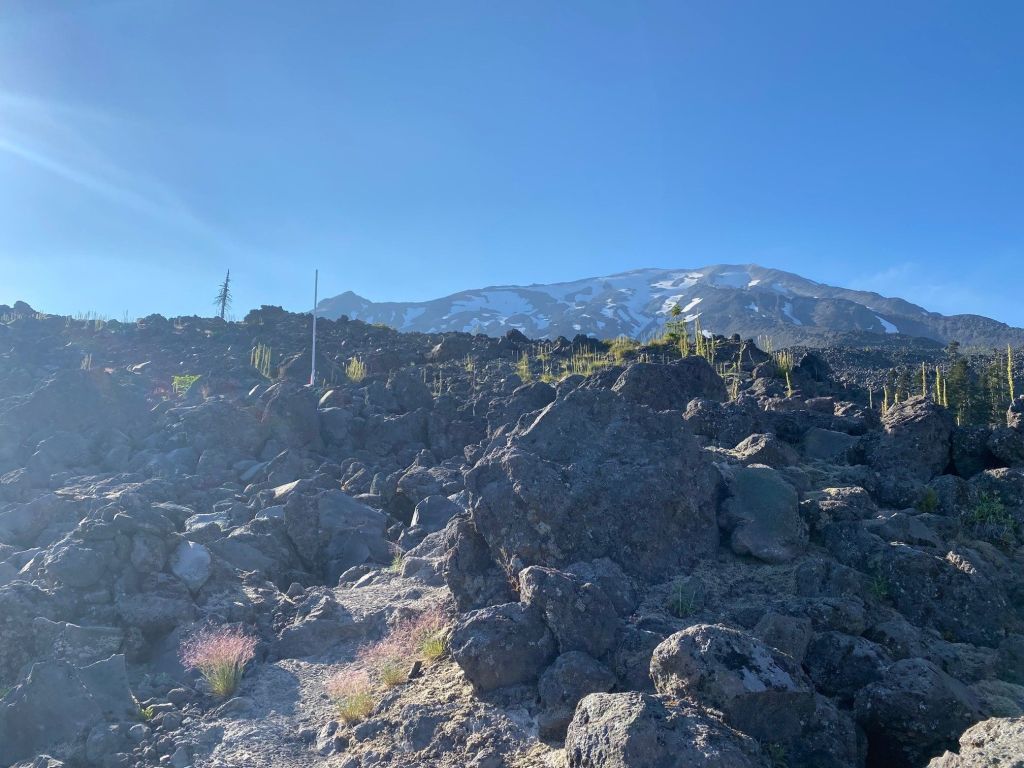
Almost everyone I passed on this section was sitting on a rock and staring into space. They all said they were fine and good on water, so onward I went. This is when my mood, for the first time all day, darkened a bit. I was still appreciating the experience, but when you can smell the hay in the barn and not get there fast enough it begins to wear.
At one point, the trail ducked into the forest and I thought “this is it! The boulder fields are done. I’m in the shade!” I popped off my hood, took off my hat and my sunglasses, rolled up my sleeves, and started running. Feeling free and breezy. Until about a half mile later I popped back out into…

The sun felt so hot. My hat and hair had been wet all day to keep cool and I just wanted to feel human again. But the hat went back on, I smeared some sunscreen on my face, and I re-started the process of looking for the pole/flag, looking back down, and hopping and climbing until I got there. Then again. And again.
Finally, I rejoined with the trail heading back to the Sno Park, and with the guy who had passed me earlier. We ran together for a while but he had more left in his legs, so he zoomed off. I thought I still had two miles left, so was alternating running and walking but suddenly saw a sign saying the Sno Park was a half mile away. Ah, GPS watches, eye-roll.
I kicked it into high gear and ran as fast as I could over the finish line, smiling and crying and over an hour earlier than I had planned. I hugged Louis and accepted ice cold lemonade from a really kind lady. Here is a video Louis took of me. My face is caked with zinc sunscreen, my race vest is smeared with Ucan superstarch, and I am done running for the day.
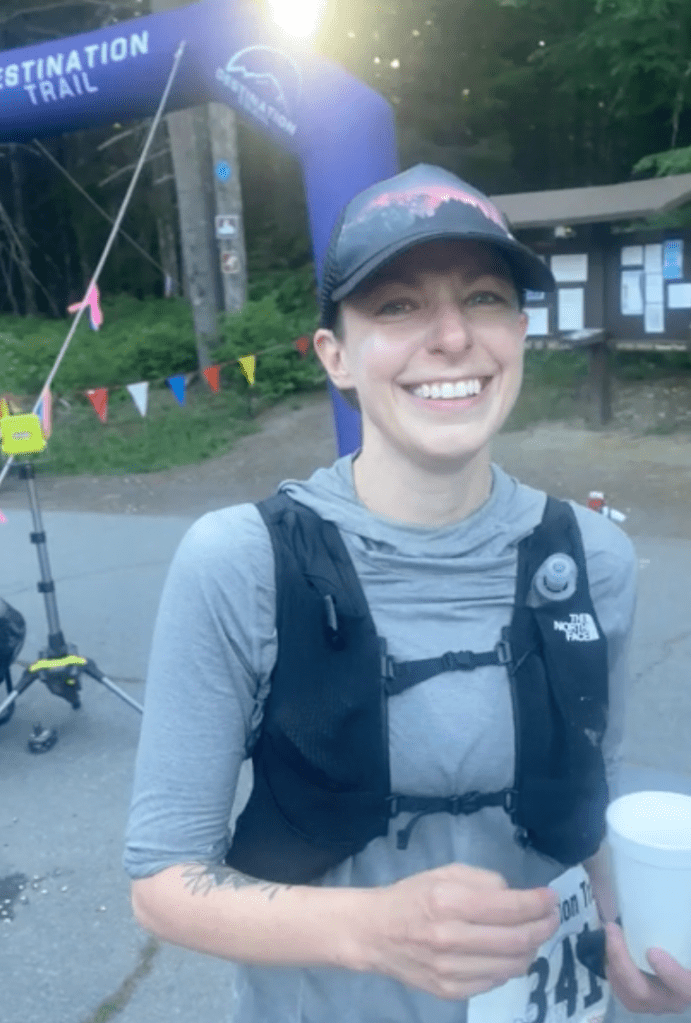
The Results
Almost A Goal! Finished in 12:24:39
I was so sure that my A goal wasn’t possible that I never actually internalized it, even when it was within reach. In hindsight, I could have shaved off 22 minutes easily but, because I had never ran more than 31 miles, I fully expected to blow up somewhere beyond that. I only realized that finishing in under 12 hours would have actually meant something to me after I finished, but I’m really happy with what I was able to do fully relaxed, carefully and methodically, and in good spirits and health.
· 43rd place overall
· 12th place female
· 9th in age category, men and women (34 finishers, 5 DNF)
· 1st in age category, women (10 finishers)
(Coach note – these are considerably better place results than Sara has experienced in past races)
I’m really happy with the race, and that’s an understatement. I’ve never experienced such a consistently good mood during a long effort, had better results, or recovered faster.
After a week of doing basically nothing, I’m excited to start training again next week, and focusing the rest of the season on fastpacking, daylong missions, and camping. I’ll also be working in the medical tent during the Moab 240, putting my WFR (Wilderness First Responder) skills to the test.
The Debrief (by Coach Kym)
A huge part of my coaching is Debriefing and Planning sessions. We spend a lot of time discussing and analyzing everything from specific exercises to training data averages to the psychology of a race. This always informs planning; from the big picture life goals to the minutia of the next steps. Five years ago I would prepare all of the data and questions for Sara. These days she writes up a thorough debrief all on her own and then we discuss it together.
There was a long list of the little things that worked well, as well as the that didn’t work. Most importantly Sara identified three major factors that contributed to the success she experienced. They were:
1. Moving across the country to a place that better matched the lifestyle she wanted to live.
2. Reducing stress and inflammation through both nutrition and relationship changes.
3. Embracing the specialized kind of athlete she is.
There are all sorts of new goals and plans in the works. While at this point Sara is capable of coaching herself, it is so wonderful to continue to mentor and support her as she takes on new goals.

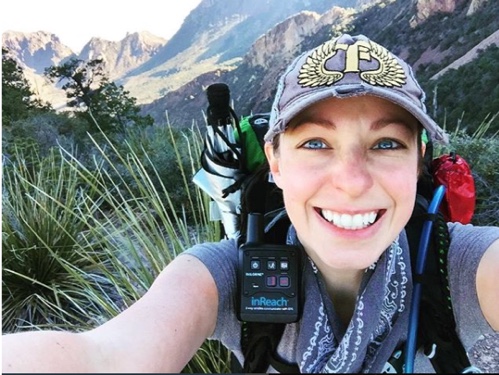
OMG
Fantastic to read every word of your story! Thank you for sharing!
Wow. I was on the edge of my seat as I read this entire story
Sent from my iPad
>
I’m glad you enjoyed it!